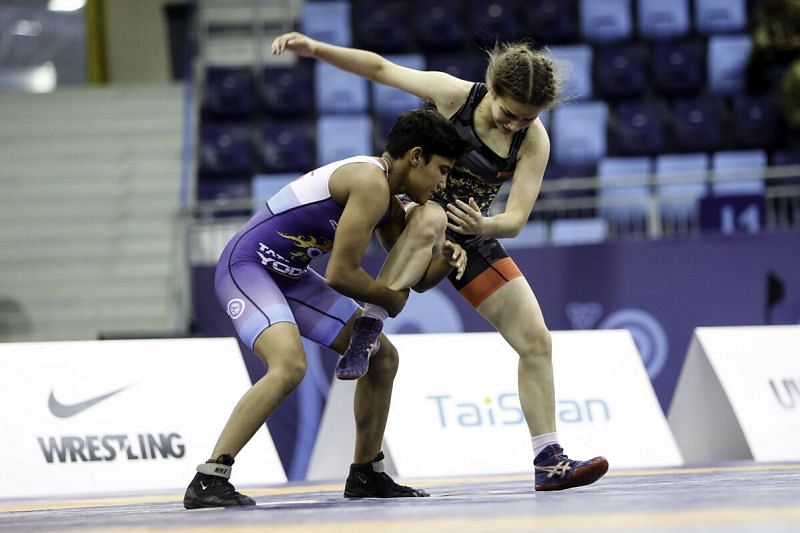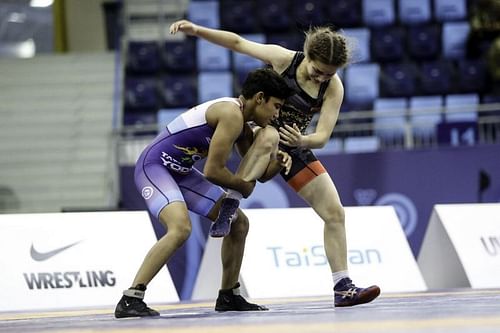
Fends off village bullies, fights Covid lockdown, wins Cadet Worlds twice: Komal now chases Olympic glory

Komal received a rousing welcome when she returned to her village of Patti Kalyana in Haryana’s Panipat district. After all, the 16-year-old had just become the first Indian since Sonam Malik to win two consecutive Cadet World Championships. She defeated Azerbaijan’s Ruzanna Mammadov in the final of the 46kg category to clinch the title last month.
“What she has done cannot be expressed in words. But I can say this, that my daughter has done something extraordinary. I am so proud of her,” says her father Satish Kumar, trying to hold back tears of joy.
But Komal is not your everyday wrestler. She derives her grit and tenacity from her experiences in life. Her mother, Kusum, says her daughter has been a fighter since childhood.
Komal hails from a very humble background. Her father is a migrant worker and does odd jobs to make ends meet. Kusum, on the other hand, prepares mid-day meals at a government school. It is a family of seven – Komal has two older sisters and one younger brother and sister.
She may be a two-time world champion, but Komal does not look the part. But don’t let her innocent face, lanky frame and normal build fool you. When she steps onto the mat she takes on a different persona: Komal turns into a romping machine.
A technically superior wrestler
Komal makes up for her lack of strength with nimble movement and relentless leg attacks. She uses her technical superiority to wear down her competitors.
In the words of India’s cadet women’s team national coach Virender, Komal is a rare find. Unlike other wrestlers who rely heavily on strength, she puts her faith in technique and foot movement.
“She reminds me of Japanese and American wrestlers. She would keep moving, keep her guard up and look for openings to either move to the side and attempt a takedown or go for the legs,” he says.
Komal’s favorite attack is getting into a standing lock and quickly grabbing the foot of her opponent to effect a takedown. Virender says this is her natural move and, although many of the wrestlers know about it, they still find it hard to counter.
“It’s just hard to evade that attack. She has used it so often at national level that many good wrestlers know it is coming but they still find themselves getting caught unawares. One reason for it is because you are in an attacking stance and locked, and it’s hard to suddenly move into a defensive position,” he says.
Bullied into wrestling!
On digging a little deeper, we realize that there is more than meets the eye.
The teenager’s tryst with wrestling started at the Baba Gyan Ram Akhada, where she used to go with family members to watch local dangals (wrestling competitions).
She used to be bullied by the akhada boys, who would beat her up whenever they spotted her watching a bout.
“People think the situation has changed for women in Haryana, but, in reality, they are wrong. As a kid, there were local boys around her age, and some even older, who would bully her for entering the akhada. They would ask her to leave, since, for them, wrestling was a man’s sport. Then, one day, she came home with a swollen lip and told me she wanted to learn wrestling. That is when her journey started,” her father remembers.
The incident was enough to toughen Komal. Her first coach, Krishnan, swears by her determination and discipline and feels that she is a natural.
“She is very disciplined and hardworking. She is a natural. I did not have to work a lot with her as, whatever I told her, she would grasp quickly. She just loves takedowns and is one of the most unpredictable. Many of her moves are from the time when she would fight those bullies,” he says.
Within two years of taking up wrestling, Komal started making her presence felt at the international level. In 2019, she won both the Cadet Asian and World Championship gold medals. She also won the U15 Asian Championship title the same year.
However, just when she was getting better, COVID-19 struck and halted her rise. The family's financial condition worsened to the point that they could not even manage three square meals, let alone a proper diet for Komal.
“We are a big family. When the lockdown happened, everything became very tough. My husband had no work and there was no source of income. We would get some money from Komal’s sponsorship that would help us survive,” says Kusum.
Wrestlers need a high-protein diet which includes lots of dairy products such as milk and butter and lots of almonds. Komal, however, had to make do with cucumber and fruits.
All these experiences made her more determined.
“Yes, there are problems, but I am still training to realize my dreams. This is what I want to do. And I will do it, no matter what,” Komal says after much coaxing.
Komal dreams of becoming the next big thing in Indian wrestling. She wants to follow in the footsteps of Sakshi Malik – India’s first woman Olympic medalist – and wants to establish her own identity.
She trains twice and sometimes even thrice a day at the local akhada in her village.
“I am currently focusing on my endurance and weight training. My coach is helping me too,” she says.
Driven by passion, she is chasing history and dreams of finishing on the Olympic podium. She knows things will be different once she becomes an Olympic champion.
“I know how wrestlers are treated once they become Olympians. But I want more. There is already an Olympic bronze medalist and that is Sakshi Malik. She is an inspiration but I want to surpass her. I want to be an Olympic champion,” says Komal.